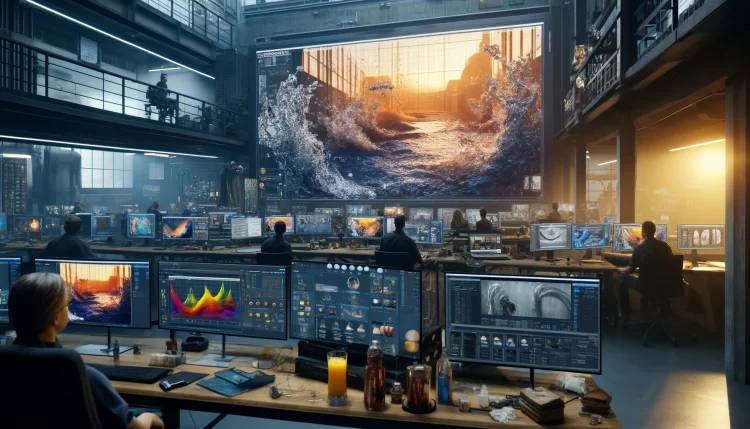Liquid Effects VFX
In the competitive and ever-evolving film industry, the right visual effects VFX can make or break a project. Among the various VFX specializations, liquid effects stand out for their ability to add dynamic realism and aesthetic appeal to films. Whether you’re creating a dramatic ocean scene, a subtle water ripple, or a powerful liquid explosion, choosing the right liquid effects VFX studio is crucial. This guide aims to provide filmmakers with comprehensive insights on how to select the best VFX studio for their liquid effects needs.
Understanding Liquid Effects in VFX
What Are Liquid Effects?
Liquid effects involve the simulation of fluid behaviors such as water, oil, lava, and other liquids to create realistic and visually stunning scenes. These effects require sophisticated software and a deep understanding of fluid dynamics to achieve lifelike movements and interactions.
Importance of Liquid Effects in Film
Liquid effects can dramatically enhance a film’s visual storytelling. They can be used to create natural environments, convey emotions, and add layers of complexity to the narrative. High-quality liquid effects can elevate the production value and audience engagement, making scenes more immersive and believable.

Looking for VFX
Experts or Projects?
Join Vitrina to Expand Your Global Entertainment Network
- Promote
Your VFX
Services. - Connect
with Vendors &
Studios Worldwide. - Discover
New Projects &
Opportunities - Find
Trusted VFX
Partners.

Key Considerations When Choosing a Liquid Effects VFX Studio
1. Portfolio and Track Record
Review Past Projects
One of the first steps in choosing a VFX studio is to review their portfolio. Look for projects that showcase their expertise in liquid effects. Examine the quality, creativity, and realism of their previous work. Notable projects and high-profile clients can be indicators of a studio’s capability and reputation.
Client Testimonials and Case Studies
Client testimonials and case studies provide valuable insights into the studio’s performance, reliability, and client satisfaction. Reach out to past clients if possible, to get firsthand feedback on their experience with the studio.
2. Technological Capabilities
Software and Tools
The quality of liquid effects largely depends on the software and tools used by the VFX studio. Ensure the studio utilizes industry-standard or proprietary software known for advanced fluid simulations, such as RealFlow, Houdini, or Bifrost.
Innovation and Adaptation
Technology in the VFX industry is constantly evolving. A good studio should be innovative and adaptable, regularly updating their tools and techniques to stay ahead of the curve. Ask about their approach to incorporating new technologies and methods.
3. Creative Expertise
Team Experience
The expertise and experience of the VFX team are critical. Look for a studio with a team that has a strong background in liquid effects, including skilled artists, animators, and technical directors. Their collective experience will impact the quality and creativity of the final product.
Artistic Vision
Liquid effects should not only be technically accurate but also artistically compelling. The studio should have a clear understanding of your creative vision and be able to translate it into visually stunning effects that enhance the storytelling.
4. Collaboration and Communication
Project Management
Effective project management is essential for timely delivery and quality assurance. Evaluate the studio’s project management practices, including how they handle timelines, budgets, and revisions. A dedicated project manager can significantly improve the collaboration process.
Communication Style
Clear and consistent communication is crucial throughout the project. Choose a studio that values open dialogue, is responsive to your needs, and provides regular updates. Good communication ensures that the project stays on track and aligns with your vision.
5. Budget and Pricing
Cost Transparency
Understand the studio’s pricing structure and ensure there are no hidden costs. A transparent approach to budgeting will help you avoid unexpected expenses and stay within your financial constraints.
Value for Money
While cost is a significant factor, it should not be the sole determinant. Consider the value for money—high-quality liquid effects that contribute significantly to your film’s success may justify a higher investment.
6. Timeline and Flexibility
Project Timelines
Discuss the studio’s availability and ability to meet your project deadlines. Ensure they have the capacity to deliver high-quality work within your required timeframe without compromising on quality.
Flexibility and Adaptability
Film projects often encounter changes and unforeseen challenges. A good VFX studio should be flexible and adaptable, capable of handling revisions and adjustments smoothly.
7. Industry Reputation and Awards
Awards and Recognition
Industry awards and recognition can be indicators of a studio’s excellence and innovation. Studios that have received accolades for their liquid effects work are likely to deliver top-tier results.
Professional Associations
Membership in professional associations such as the Visual Effects Society (VES) can also signify a studio’s commitment to industry standards and continuous improvement.
Looking for Global VFX Projects?
Create your profile on Vitrina!
- Promote your VFX studio.
- Connect with global studios.
- Showcase projects & clients.
- Find projects matching your expertise.

Step 1: Define Your Project Requirements
Clearly outline your project’s VFX needs, including the type and complexity of liquid effects required. Consider the artistic vision, technical specifications, and any unique challenges your project may present.
Step 2: Conduct Research and Shortlist Studios
Conduct thorough research to identify potential VFX studios. Use industry directories, online reviews, and professional networks to create a shortlist of studios that specialize in liquid effects.
Step 3: Evaluate Portfolios and Proposals
Review the portfolios of shortlisted studios to assess their expertise and style. Request proposals detailing how they would approach your project, including timelines, budgets, and creative ideas.
Step 4: Schedule Meetings and Interviews
Schedule meetings or interviews with the top candidates. Use this opportunity to discuss your project in detail, assess their understanding of your vision, and gauge their enthusiasm and commitment.
Step 5: Check References and Testimonials
Reach out to past clients and check references to gain insights into the studio’s reliability, work quality, and client service. Testimonials can provide valuable feedback on their performance.
Step 6: Negotiate Terms and Agreements
Once you have identified the best fit, negotiate the terms and finalize the contract. Ensure all aspects of the project, including timelines, deliverables, and payment terms, are clearly defined.
Step 7: Monitor Progress and Maintain Communication
Maintain regular communication with the studio throughout the project. Monitor progress, provide feedback, and address any issues promptly to ensure the project stays on track and meets your expectations.
Top Liquid Effects VFX Studios to Consider
Choosing the right liquid effects VFX studio is a critical decision that can significantly impact the success of your film project. By considering factors such as portfolio, technological capabilities, creative expertise, communication, budget, and reputation, you can find a studio that aligns with your vision and delivers high-quality results. The top studios listed here are renowned for their exceptional work in liquid effects, offering filmmakers a range of options to bring their projects to life with stunning visual effects.
Summary
Choosing the right liquid effects VFX studio is a critical decision that can significantly impact the success of your film project. By considering factors such as portfolio, technological capabilities, creative expertise, communication, budget, and reputation, you can find a studio that aligns with your vision and delivers high-quality results. The top studios listed here are renowned for their exceptional work in liquid effects, offering filmmakers a range of options to bring their projects to life with stunning visual effects.
When choosing a liquid effects VFX studio, consider their portfolio and track record, technological capabilities, creative expertise, communication and collaboration skills, budget and pricing, timeline and flexibility, and industry reputation and awards. These factors will help ensure the studio can meet your project’s specific needs and deliver high-quality results.
Evaluate a VFX studio’s portfolio by reviewing their past projects that showcase liquid effects. Look for realism, creativity, and technical proficiency in their work. Additionally, consider the complexity and diversity of the projects they have handled, as well as any notable clients or high-profile films they have worked on.
Technological capability is crucial because the quality of liquid effects depends heavily on the software and tools used. Advanced software like RealFlow, Houdini, or Bifrost enables the creation of realistic fluid simulations. A studio that regularly updates its technology and adapts to new innovations can deliver superior VFX.
Communication is vital for ensuring that the VFX studio understands your vision and can translate it into the final product. Clear and consistent communication helps keep the project on track, allows for timely feedback and revisions, and ensures that both parties are aligned throughout the project.
To ensure a VFX studio can meet your budget requirements, discuss their pricing structure and request a detailed proposal that outlines all costs. Look for transparency in their pricing and ask about any potential hidden costs. Balancing cost with value for money is important to ensure you get high-quality results within your budget.




































